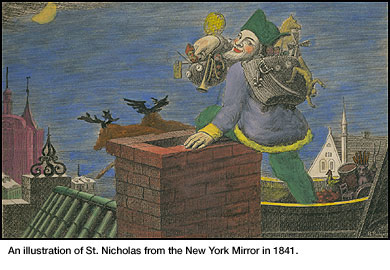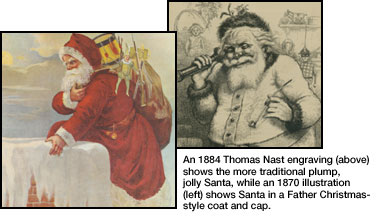|
|
||
|
|
|

"Night Before Christmas" Series Reveals Evolution of St. Nick
�
The image changes throughout the years: Santa sporting knee britches, Santa in a Father Christmas-style coat, Santa clad in a hot pink Santa suit.
But the evolution of Santa's fashion sense is only one of the many stories told by the Anne Lyon Haight Collection of "A Visit from St. Nicholas." Housed in Carnegie Mellon's Hunt Library, the collection contains close to 400 editions of the poem, more commonly known as "'Twas the Night Before Christmas."
The collection was started in the 1930s by author and bibliophile Anne Lyon Haight and donated to Carnegie Mellon by her children after her death in 1982. The collection contains nearly all of the editions of the poem published in its almost 200-year existence. The only one missing is the first one that appeared in the December 23, 1823, issue of The Troy Sentinel.
As one of the world's most widely read poems, "'Twas the Night Before Christmas" has strongly influenced society's conception of Santa Claus and transformed America's perception of St. Nicholas. Before the poem's publication, St. Nicholas was portrayed as a lanky, stern bishop who visited children to dispense both gifts and discipline. "'Twas the Night Before Christmas" recast St. Nicholas as a cheerful, rosy-cheeked elf and established Christmas as a time for giving gifts to children.
While the poem itself remains unchanged by time, the illustrations accompanying the poem present a chronological depiction of how Santa has changed and adapted to the times. Over the years, the poem has been illustrated by a diverse collection of artists, including Thomas Nast, Grandma Moses, Jessie Wilcox Smith and Arthur Rackham.
"The depiction of Santa in knee britches demonstrates that the poem has been nostalgic from the beginning," said Johnsen. "While the poem was meant to be read to young children, the illustrations accompanying it were primarily for the children's parents. The illustrations are representative of how things were when the parents were children."
While Santa's costume has always been predominantly red, different illustrations of the poem contain subtle changes reflective of the time period. From 1880 until 1930, Santa is featured wearing a long, Father Christmas-style coat. A 1958 version of the poem shows a hatless, bald Santa —a rarity, as Santa is almost always shown wearing a cap. In the 1960s, Santa's clothing became even more representative of popular culture. Neon oranges and acid greens prevail, while Santa is seen soaring through the sky in his hot-pink sleigh.
Like the evolution of Santa's appearance, the poem's actual format has gone through interesting changes. As time progressed, the intended audience for the poem became increasingly apparent. Although the 1849 edition features colorful illustrations, the book's small text demonstrates that the poem was meant to be read to young children by parents. But by 1929 the poem featured larger type for kids to read on their own. Several editions from the 1930s are printed on cloth, making them more durable. By 1958, publishers began treating the book as a toy, with pages shaped like Santa and his sack and covers that featured textured cloth.
"'Twas the Night Before Christmas" has been entertaining adults and children alike for generations, but it recently became the center of media coverage and controversy when its authorship was called into question. The poem first appeared in 1823 as an anonymously penned work and its author remained unknown until 1837, when it appeared in The New York Book of Poetry credited to wealthy Manhattan biblical scholar Clement Clarke Moore.
In 1999, descendants of Henry Livingston Jr., a Dutch poet, began insisting that it was Livingston, not Moore, who penned America's most popular holiday poem. With the help of Vassar College's Donald Foster, a world-renowned literary detective and scholar of authorial attribution, Livingston's family claim that Moore fraudulently took credit for Livingston's work.
Foster cites an abundance of evidence supporting the Livingston's claim. Livingston's own children wrote accounts of hearing their father read the poem on Christmas 15 years before it was first published. Foster also argues that it would have been unlikely for Moore, a stern parent with a short temper, to pen such a playful poem. Records also state that before stepping forward to accept ownership of the poem, Moore wrote to the owner of The Troy Sentinel to ask if anyone knew of its origins. After being informed that everyone who knew of its roots had since died, Moore published the poem in a volume of his own collected works.
Johnsen says that until a major publication attributes the poem to Livingston, the collection will continue to be catalogued under Moore's authorship. In her eyes, the discrepancy over the authorship of the poem simply adds another dimension to an already captivating piece of history.
"It's just one poem, but there really are so many different angles to it," said Johnsen. "There are still so many questions left to be answered."
�
�
�
�
�
�
�
Top�
�
�
—Bethany Elder
|
|
This Issue's Headlines || Carnegie Mellon News Home || Carnegie Mellon Home |
||
 "''Twas the Night Before Christmas' is all about memories and expectations," said Mary Catharine Johnsen, Carnegie Mellon's special collections librarian. "Most people know the poem. However, based on the edition they grew up with, they have different interpretations of how Santa looks."
Stating only that Santa was "dressed all in fur, from his head to his foot," the poem provides little information about Santa's appearance. In the first illustrated version of the poem, dated 1849, Santa Claus wears a fur hat, fur jacket and knee britches, even though most men wore full-length pants by the late 1840s.
"''Twas the Night Before Christmas' is all about memories and expectations," said Mary Catharine Johnsen, Carnegie Mellon's special collections librarian. "Most people know the poem. However, based on the edition they grew up with, they have different interpretations of how Santa looks."
Stating only that Santa was "dressed all in fur, from his head to his foot," the poem provides little information about Santa's appearance. In the first illustrated version of the poem, dated 1849, Santa Claus wears a fur hat, fur jacket and knee britches, even though most men wore full-length pants by the late 1840s.